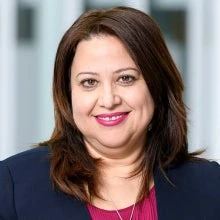
You know the say. Tough times always reveal true friends. This is how I felt during a virtual high-level dialogue with ICT ministers, regulators, CEOs of telecom and tech companies from around the world co-hosted by the World Bank, the International Telecommunication Union (ITU), GSMA, and the World Economic Forum (WEF). In the face of a formidable foe, we all spoke in unison and committed to do all it takes to harness digital technologies to alleviate the impact of COVID-19 on people, governments, and businesses. The mood on WebEx was subdued but the desire to join forces for fast impact was palpable. Time was not on our side. We gathered virtually to discuss a set of emergency measures to keep the world connected. And walk the talk.
Makhtar Diop, the World Bank’s Vice President for Infrastructure, in his welcoming remarks, reminded us that the benefits and opportunities of technology are not equally distributed. In the informal economy, there is no such thing as telecommuting, he noted. One and a half billion children in the world need online schooling due to the COVID-19 outbreak, but online education is not even a remote dream for millions of unconnected kids. “Now is the time to fast track our efforts and respond in a concerted way to the new challenges that the pandemic brought to the fore,” he said while introducing a grand scheme for collaboration on the digital agenda. Doreen Bogdan-Martin, Director of the Development Bureau of the ITU, reminded us that: “3.6 billion people on the planet still don’t have internet access. And billions more are not meaningfully connected.”
Let’s not let a crisis go to waste
The private sector had answered our call en masse. Mats Granryd, Director General of the GSMA, opened a session on promoting network resilience by mentioning that 15 CEOS of mobile companies, representing 25% of the planet’s mobile connections, were connected to participate in this dialogue. “Operators are investing in added capacity in order to ensure their networks remain as robust and secure as ever. In some cases, however, temporary measures and emergency telecommunications plans by governments and regulators could help alleviate pressure on networks and ensure network resilience and continuity of access to the full range of services by consumers and businesses,” he noted.
Ministers and regulators from the four corners of the globe eloquently described the challenges their countries face to respond to the surging demand for connectivity. H.E. Fahim Hashimy, Afghanistan’s Minister of Telecommunication and Information Technology —a country where voice-driven infrastructure isn’t strong enough to accommodate the current data demand—described his government’s efforts to facilitate infrastructure sharing, including releasing dark fiber and providing discounts on the wholesale price of fiber. “This crisis has brought the government and private sector much closer than ever before,” he noted. “The relationship between government and industry had never been so good,” argued Mauricio Ramos, CEO of Millicom, a leading provider of mobile services in Latin America and Africa.
H.E. Roberto Sanchez, Spain’s Secretary of State for Telecommunications and Digital Infrastructure, talked about Spain’s regulatory-driven approach to provide connectivity for all while Ajit Pai, Chairman of the U.S. Federal Communications Commission, described the market-based approach adopted by the United States through the “Keep America Connected” pledge (more than 700 companies have signed the pledge so far). Rob Shuter, CEO of MTN, praised South Africa for releasing emergency spectrum for the duration of the lockdown. “Access to equipment is critical in developing markets,” he noted. Shuter highlighted the importance of treating telecoms as an essential service and noted that steps must be taken to ensure shipments are released from customs faster. Ensuring connectivity for all also means behavioral changes, a point highlighted by several participants. Nick Clegg, Facebook’s head of Global Affairs, said that Facebook has reduced bitrates for on-demand videos, rather than simply relying on members to adjust their behavior.
Making data work against COVID-19
Using data for better decision-making was also on top of our minds. So was cybersecurity. Derek O’Halloran, Head of the Future of Digital Economy for the WEF, chaired a session on leveraging connectivity and Big Data to address the health crisis. Antonio Neri, CEO of Hewlett Packard Enterprise, and José Maria Alvarez-Pallete, CEO of Telefonica, highlighted concerns about a surge in cyberattacks while Dan Sjöblom, Director General of the Swedish Post and Telecom Authority insisted on the importance of protecting both consumer and privacy rights— even in emergency contexts such as this one. “Whenever these restrictions are over, it’s not going to be the same…it’s like we’ve been put into a time machine, and digitalization has been accelerated. The way we work, the way we learn, the way we buy has totally changed, and therefore we need to be prepared for that,” said Alvarez-Pallete. Business unusual will become the new normal.
Following this high-level dialogue, the World Bank, ITU, GSMA and WEF finalized and published a joint action plan featuring immediate and high impact measures to keep the world connected, prevent the internet from breaking, and connect the unconnected. In a flash, we moved from talk to action. The stakes are too high for inaction. In the words of Doreen Bogdan-Martin: “Never before has digital been so vital.” We need to ensure that digital solutions are not only part and parcel of our immediate response to weather the shock; but also, a key foundation for fast-tracking economic recovery in the aftermath of the pandemic.



Join the Conversation